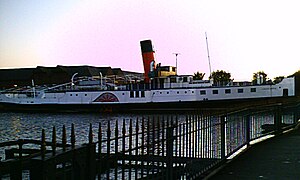Lincoln Castle (ferry)

The PS Lincoln Castle in Alexandra Dock, Grimsby.
|
|
| History | |
|---|---|
|
|
|
| Name: | PS Lincoln Castle |
| Namesake: | Lincoln Castle, Lincoln, England. |
| Owner: | 1941-1978: LNER; British Rail; Sealink |
| Operator: | LNER; Sealink |
| Port of registry: | Grimsby, Lincolnshire |
| Route: |
|
| Ordered: | 1939 |
| Builder: | A. & J. Inglis, Pointhouse, Glasgow |
| Christened: | 27 April 1940, 4:30 p.m. |
| Completed: | 4 July 1941 |
| Maiden voyage: | 4 August 1941 |
| In service: | 1941-1978 |
| Homeport: | Grimsby, Lincolnshire |
| Status: | broken up in Alexandra Dock, Grimsby: restoration pending by LCPS |
| General characteristics | |
| Type: | Paddle steamer |
| Tonnage: | 598 GT |
| Length: | 209 ft (64 m) |
| Beam: | 56 ft (17 m) (including paddle box) |
| Propulsion: | Triple expansion, diagonal stroke, reciprocating steam engine by Ailsa of Troon, 850 hp. |
| Speed: | 12.0 knots (22.2 km/h; 13.8 mph) |
PS Lincoln Castle was a coal-fired side-wheel paddle steamer, which ferried passengers across the Humber from the Second World War until 1978. She was the last coal-fired paddle steamer still in regular services in the UK. Later, she served as a pub at Hessle, and then as a restaurant under permanent dock in Alexandra Dock Grimsby. In September 2010, the Hull Daily Mail reported that she was in an advanced state of demolition, despite the efforts of local people to buy the historic vessel and restore her. On 31 March 2011, The Lincoln Castle Preservation Society were reported to have purchased the broken up parts of the ship for restoration.
The PS Lincoln Castle was built as a great refinement on the earlier Humber ferry sisters, the PS Tattershall Castle and PS Wingfield Castle and was a different vessel in concept and construction. She had a straight stem and counter stern with the usual good lines of such a vessel though the paddle boxes and sponsons could give an impression of a greater beam. Her length was 209 feet (64 m) and beam 33 feet (10 m), excluding sponsons. She could carry up to twenty cars (on the after deck) and 1,200 passengers.
The PS Lincoln Castle was built with good reason in a different yard from the earlier vessels with a different engine with different layout and vastly different accommodations and equipment as any user of the three would amply testify. It was conceived of as a greatly improved vessel and specification built on experience of some six years with the earlier pair of vessels and other paddle steamers. This vessel was unique; the ultimate design of its type as a sheltered-water paddle-steamer ferry and more advanced than the earlier two on this service from the engineer’s and passengers’ viewpoints, with superior passenger accommodation and a logical engineering layout, intentionally affording passengers unequalled views of the engine room and the engine in operation.
All her working life, her boiler was coal-fired and its steam used to power a triple expansion diagonal reciprocating engine. This engine, built by Ailsa of Troon, Scotland, was a rare survivor of its type from this manufacturer and of particular historical significance due to its survival within the hull of its intended vessel. The cylinders were respectively 18 and 28.5 and 46 inches (0.46 and 0.72 and 1.17 m) in diameter with a 51 inches (1.3 m) stroke. The PS Lincoln Castle was different from the other vessels in the Humber ferry service in having her boiler forward of her engine, therefore her funnel was further forward than the others; just before midships, abaft the bridge and halfway between her two equally-sized masts.
...
Wikipedia
